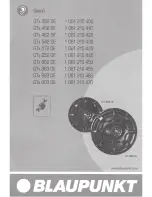
LOW IMPEDANCE
Radio and tape players may be wired direct from their respec-
tive speaker output terminals. The advantage of this low im-
pedance method is that no modification is required to the radio
or tape unit. Performance will usually be quite satisfactory,
although not optimum. When using low impedance inputs, the
gain adjustment screws on the top of the preamp must be
turned fully counter-clockwise (see page 7).
MODIFICATION INSTRUCTIONS FOR HIGH
IMPEDANCE OUTPUT JACKS
A professional audio technician should perform this modifica-
tion. The procedure is as follows:
The tape or radio unit must be removed from the car and the lid
or case opened. Locate the volume control. It may be of the
rotary or slider type and will have three lugs for each channel.
Locate the ground lugs and connect to the input cable shield.
Next, locate the centerwiper lugs and disconnect the wires that
connect to the amplifier section. Then attach input cable to the
respective lugs.
NOTE: In some cases, the balance control is wired after the
volume control. It will be necessary to trace the circuit to see
which type of circuit you are working with. On models with the
balance control after the volume control, connect The Punch’s
input cables after the balance control in order to retain adjust-
able balance.
When the correct location is found, connect the red and black
wires to the left and right channels.
In some rare cases, the signal may be too low at this point to
drive The Punch to full level. If so, it will be necessary to tap into
the signal after it passes through the next amplifier stage.
Although rare in automotive radios and tape players, occasionally
one will use a “loudness” type of volume control which can be
identified by the four lugs for each channel on the volume
control. The loudness circuit should be disabled by either
disconnecting the wiring that runs to the loudness tap or by
shorting it to ground.
5































